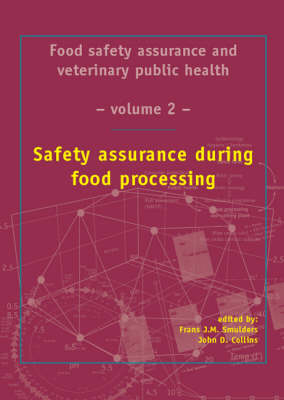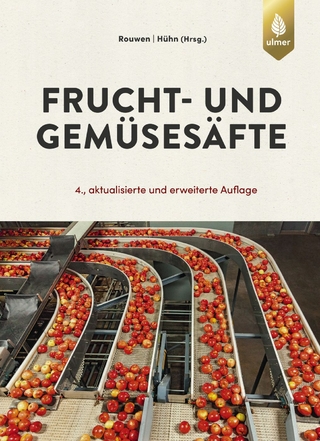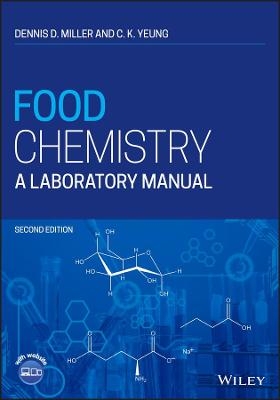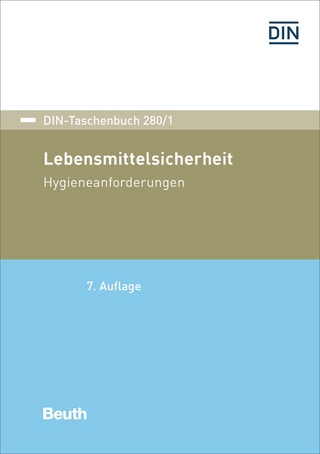
Safety assurance during food processing
Wageningen Academic Publishers (Verlag)
978-90-76998-06-0 (ISBN)
- Keine Verlagsinformationen verfügbar
- Artikel merken
"Microbial agents (particularly bacteria) represent the greatest risk to public health. The traditional end-product oriented food inspection systems are inadequate for identifying and eliminating the usually symptomless animal carriers of agents causing foodborne infections and intoxications. Modern, risk-based, prevention approaches are the only effective way to reduce the prevalence of these hazards from our foods. As an additional 'safety-valve' microbial decontamination procedures are currently being suggested and its implementation in industrial food processing has, at least in some parts of the world, met with governmental approval. The residues in foods of some non-microbial agents have more recently also caused substantial consumer disquiet. This equally applies to non-conventional foods containing GMO's.
In this publication these issues are addressed by invited expert scientists from various disciplines, many of which have key-positions in EU-funded research programmes on these very topics and/or are advisers to international public health bodies. The editors firmly believe that the very nature of the theme, the excellence of the papers and the holistic approach chosen will draw an audience from both an industry and academic background."
Preface 15; Keynote contributions 17; Food Safety - a worldwide public health issue Actions to reverse the upward curve of foodborne illness 19; Friedrich K. Kaferstein; 1. Introduction 19; 2. Factors of significance for food safety 20; 3. Emerging pathogens / issues 23; 4. Prevention and control 25; 5. Responsibilities for the prevention of foodborne illness: the concept of shared responsibility 27; 6. Conclusion 31; Acknowledgement 31; References 31; Public health issues in dairy production and the implications on the safety of aged cheeses made with raw milk 33; Luisa Pellegrino and Catherine Donnelly; Summary 33; 1. Introduction 33; 2. Previous reviews on the safety of raw milk cheeses 35; 3. Outbreaks involving cheddar cheese 36; 4. Challenge studies 38; 5. Pathogens in raw milk 45; 6. Stress adaptation of pathogens and impact upon cheese safety 47; 7. Improvement in cheese safety 48; 8. Conclusions 50; References 50; Major pathogens associated with the processing of beef 57; John M. McEvoy, James J. Sheridan and David A. McDowell; Summary 57; 1. Introduction 57; 2. Sources of carcass contamination 58; 3. The presence and prevalence of E. Coli O157:H7 and Salmonella in cattle and on carcasses 60; 4. The rumen and faeces as sources of contamination 61; 5. Carcass contamination 63; 6. Seasonality, systems, study design and sensitivity 64; 7. The movement of pathogens on carcasses during processing 66; 8. Conclusions 72; References 73. Research update on major pathogens associated with the processing of poultry and poultry products 81; Luppo I. Ellerbroek; Summary 81; 1. Introduction 81; 2. The key microorganisms - agents of foodborne disease 83; 3. Control measures at different stages of processing 91; 4. Conclusions 92; References 92; Research update on major pathogens associated with the processing of pork and pork products 99; Jos M.A. Snijders and John D. Collins; Summary 99; 1. Introduction 99; 2. Important pathogens 100; 3. The pork production chain 102; 4. Salmonella detection in live pigs and in pork 102; 5. Salmonella infection in pigs 103; 6. Transport and stress 104; 7. Lairage 104; 8. Slaughterline 105; 9. Control in slaughter lines 107; 10. Recommendation for reducing contamination in the pork production chain 109; 11. Conclusions 110; References 111; Research update on major pathogens associated with fish products and processing of fish 115; Tiina J. Autio, Miia K. Lindstrom and Hannu J. Korkeala; Summary 115; 1. Introduction 115; 2. Processing of Fish Products 116; 3. Major Pathogens 119; 4. Conclusions 130; References 130; Use of statistical methods to assess food safety 135; Klemens Fuchs; Summary 135; 1. Introduction 135; 2. Nationwide Strategies 136; 3. Plant Specific Concepts 140; References 143. Predictive modelling to control microbial hazards in the food processing industry 145; Jozsef Baranyi; Summary 145; 1. Introduction 145; 2. Primary models 147; 3. Secondary models 150; 4. Creating predictive software packages 152; 5. Measuring the performance of predictive models 154; 6. Conclusions 155; References 156; Elimination of foodborne pathogens by ionising radiation 157; Jozsef Farkas; Summary 157; 1. Introduction 157; 2. General Scientific and Technological Considerations 158; 3. Radiation decontamination of foods of animal origin 160; 4. Safety and Legislation of Irradiated Food of Animal origin 166; 5. Food irradiation process control and detection of irradiated foods 169; 6. Recent Developments on Commercial Application of Food Irradiation 169; 7. Conclusions 171; References 172; Reduction of the microbial contamination of carcasses and meat cuts with particular reference to the application of organic acids 177; Peter Paulsen and Frans J.M. Smulders; Summary 177; 1. Introduction 177; 2. A review of microbial contamination at the "harvest" level 178; 3. Control strategies 182; 4. Microbial decontamination of carcasses and meat cuts 185; 5. Conclusions 193; References 194; Testing foods of animal origin for residues of chemical contaminants 201; Carlos H. Van Peteghem; Summary 201; 1. Introduction 202; 2. Sample types 202; 3. Screening versus confirmation 203; 4. General outlook of residue analysis 204; 5. Conclusions 210; References 211. Hormones residue testing: An update in research and approaches 213; Rainer W. Stephany; Summary 213; 1. Introduction 214; 2. Opposing aspects 215; 3. Analytical strategies 216; 4. Hormones in use as growth promoters 216; 5. Hormone residue data for edible tissues 223; 6. Conclusions 224; Acknowledgements 224; References 225; Veterinary use and antibiotic resistance 229; Michael Teuber; Summary 229; 1. Introduction 229; 2. How many antibiotics are used? 230; 3. Environmental spread of antibiotic resistance from farm animals 232; 4. Foodborne pathogens and antibiotic resistance 233; 5. Antibiotic resistance in aquaculture systems 236; 6. Conclusions 238; 7. Update 238; References 239; Food processing stresses in the spread of antibiotic resistance 243; David A. McDowell; Summary 243; 1. Introduction 243; 2. Emergence of antibiotic resistance 244; 3. The story so far 244; 4. Where do we go from here? 246; 5. Factors in the emergence and spread of ABR 247; 6. Food processing 247; 7. Modern bacteriostatic systems 248; 8. Stress and growth rate 249; 9. Supracellular stress responses and antibiotic resistance 249; 10. Biofilms and ABR 249; 11. The importance of growth rate 250; 12. No growth does not equal no activity 251; 13. When the going gets tough, the tough get going 251; 14. Food processing stresses 253; 15. Effects of bacteriostatic stress 254; 16. Mechanisms of adaptive mutations 255; 17. Adaptive mutations and ABR 256; 18. Stress, genetic plasticity and the spread of abr 256; 19. Global controls and outcomes 258. 20. Bacterial strategies to overcome stress 258; 21. Overall impact of food processing stresses 259; 22. Conclusions 260; References 260; Genetically modified food and feeds; definition and identification 267; Hermann Hortner; Summary 267; 1. Introduction 267; 2. The legal situation 267; 3. Application of GMO's in food production 268; 4. Genetic modification 269; 5. Possibilities for detection 270; 6. Molecular biological methods 270; 7. Limit of detection; Quantification 273; 8. Analytics at the BALUF 275; 9. Conclusions 276; Acknowledgement 277; References 277; Reducing the role of contact materials in the contamination of foods of animal origin 279; Constantin A. Genigeorgis; Summary 279; 1. Introduction 280; 2. Bacterial attachment and surface colonization 283; 3. General consequences of biofilm formation 286; 4. Attachment of microorganisms to food contact surfaces and parameters that affect such attachment 287; 5. Attachment of microorganisms to meat and poultry 292; 6. Control of biofilm development 296; 7. Assessing surface cleanliness 302; 8. Conclusions 304; References 305; Food additives and public health 317; Gunther F. Hammer and Karl-Otto Honikel; Summary 317; 1. Introduction 317; 2. What are food additives? 318; 3. Standards for approval of food additives and under which condition additives may be used 319; 4. Possible technological reasons for using food additives 320; 5. The "Quantum satis" concept 322; 6. Carry-over 323; 7. Health-aspects of the preservative "nitrite curing salt" 324. 8. Conclusions 328; References 329; Synopses of other conference contributions 331; Evaluation of hygienic characteristics of Italian "Fossa" cheese 333; R. Branciari, B.T. Cenci Goga, S. Rea and P. Avellini; Application of monitoring score system to catering industry 336; A. Panebianco, G. Ziino, M. Gallo and A. Giuffrida; Sensitive detection of Listeria monocytogenes in different food commodities by enrichment and real-time quantitative PCR 340; I. Hein, H. Krismer, S. Rungaldier and M. Wagner; Shiga toxin-producing Escherichia coli 0157 in sheep at slaughter and in sheep meat 342; Annet E. Heuvelink, Marije Kettelarij, Ans Zwartkruis-Nahuis and Enne de Boer; Investigation using an integrated sample PCR-pretreatment/two-step multiplex-nested PCR strategy for the simultaneous detection of L. monocytogenes and Salmonella spp. in food matrices of epidemiological concern 344; H. Krismer, I. Hein and M. Wagner; The effects of fasting on Escherichia coli and accompanying gastrointestinal microflora in cattle pre- and post-slaughter 347; C.-A. Reid, S. M. Avery and S. Buncic; Food testing by PCR: thermal processor reliability testing 349; D. Schoder, A. Schmalwieser, G. Schauberger, M. Kuhn and M. Wagner; Spread of foodborne pathogens along the unloading-to-slaughter areas at cattle and sheep abattoirs 352; A. Small, C.-A. Reid, S.M. Avery and S. Buncic; Pulsed-field gel electrophoresis characterization of shiga toxin-producing Escherichia coli O157 from hides of cattle at slaughter 353; S.M. Avery, A. Small, C.-A. Reid and S. Buncic; Impact of slaughtering, dissecting and processing on the microbial quality of turkey meat 354; Peggy Braun, Barbara Hoffmann and K. Fehlhaber. Reduction of microbial carcase contamination with high voltage electrical stimulation 358; D.S. Edwards; Toxigenesis of Clostridium botulinum type E in pasteurized rainbow trout roe during extended refrigeration 362; Sebastian Hielm, Annukka Markkula and Hanna Miettinen; Effect of relative humidity on thermal destruction of Clostridium botulinum type E spores in vacuum-packed hot-smoked whitefish 364; M. Lindstrom, M. Nevas, S. Hielm, R. Keto and H. Korkeala; Potential for spread of foodborne pathogens via abattoir wastes 367; R. Pepperell, V. Allen, A. Small and S. Buncic; Growth of Escherichia coli and Staphylococcus aureus in refrigerated poultry meat 371; M. Trevisani, A. Serraino, R. Casciano, R. Mazzette and G. Zino; A survey of the microbiological condition of sushi from Viennese retail operations 377; Dagmar Suppin, Bettina Rippel-Rachle, Erich Schopf and Frans J.M. Smulders; Prevalence and resistance of Compylobacter spp. in Styrian poultry meat 380; B. Ursinitsch, P. Pless and J. Kofer; On the hygienic status of domestic fish and fish products 383; P. Pless, H. Gruber and J. Kofer; A semi-quantitative risk assessment model for contamination of beef carcasses with Escherichia coli 0157 386; D.J. Mellor, G.T. Innocent, S.A. McEwen, W.J. Reilly, D.J. Taylor, W.B. Steele, G.J. Gunn, H.E. Ternent and S.W.J. Reid; igh pressure processing applied to foods of animal origin 389; J. Yuste, R. Pla, M. Capellas, E. Ponce, E. Beltran and M. Mor-Mur; Residues of [beta]-lactam antibiotics in bovine milk: HPLC-MS/MS confirmatory analysis after microbial assay screening 392; S. Ghidini, E. Zanardi, R. Chizzolini, M. Benedetti and G. Varisco; Epidemiological models for monitoring antimicrobial resistance in the food chain 396; S.M. Dick, G. Gettinby, D.J. Taylor and S.W.J. Reid. Antibiotic residues in milk of dairy cows after mastitis treatment 399; P. Popelka, J. Nagy, P. Popelka, J. Hajurka and S. Marcincak; Cpe- positive Clostridium perfringens - strains in spices 401; Annamari Heikinheimo, Tiia Tuupanen, Katri Jalava and Hannu Korkeala; Effect of nitrite on growth of nonproteolytic Clostridium botulinum type b in Frankfurter-type sausage 403; Riikka Keto, Miia Lindstrom and Hannu Korkeala; Adherence of persistent Listeria monocytogenes strains 405; J. Lunden, T. Autio and H. Korkeala; Efficacy of HACCP system implementation in a medium-sized meat plant producing typical Italian salami 407; D. Ranucci, D. Miraglia, R. Mammoli, F. Aloisio and M. Severini; Biographies 411; Index 419.
| Erscheint lt. Verlag | 6.1.2004 |
|---|---|
| Reihe/Serie | ECVPH Food safety assurance ; 2 |
| Sprache | englisch |
| Maße | 170 x 240 mm |
| Gewicht | 1 g |
| Themenwelt | Technik ► Lebensmitteltechnologie |
| ISBN-10 | 90-76998-06-X / 907699806X |
| ISBN-13 | 978-90-76998-06-0 / 9789076998060 |
| Zustand | Neuware |
| Haben Sie eine Frage zum Produkt? |
aus dem Bereich


